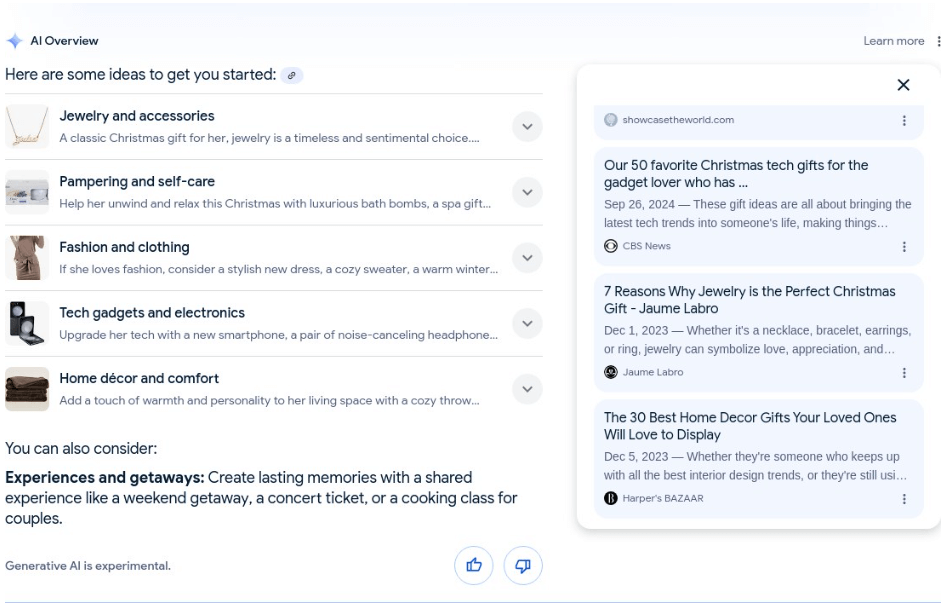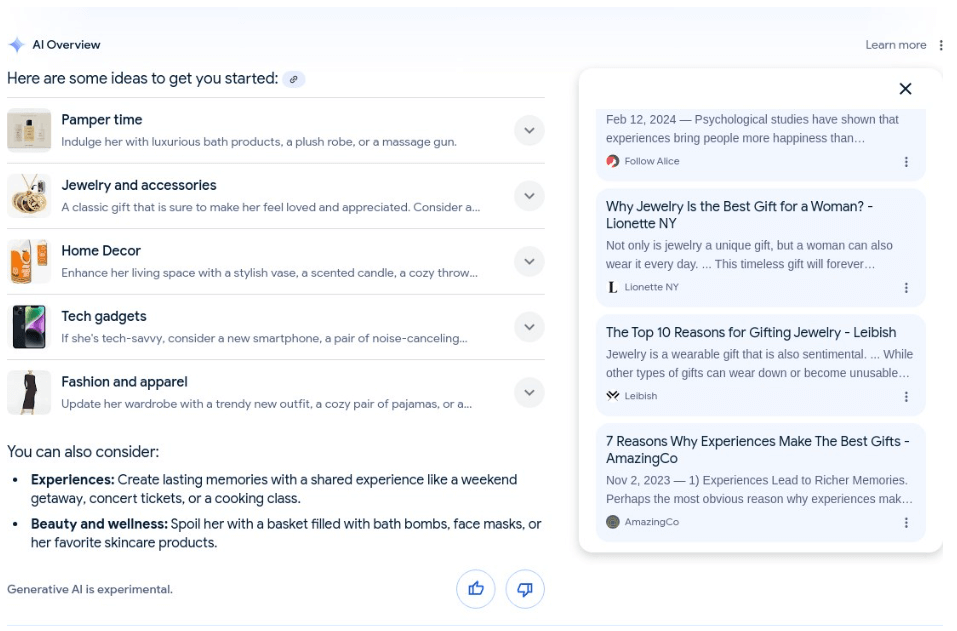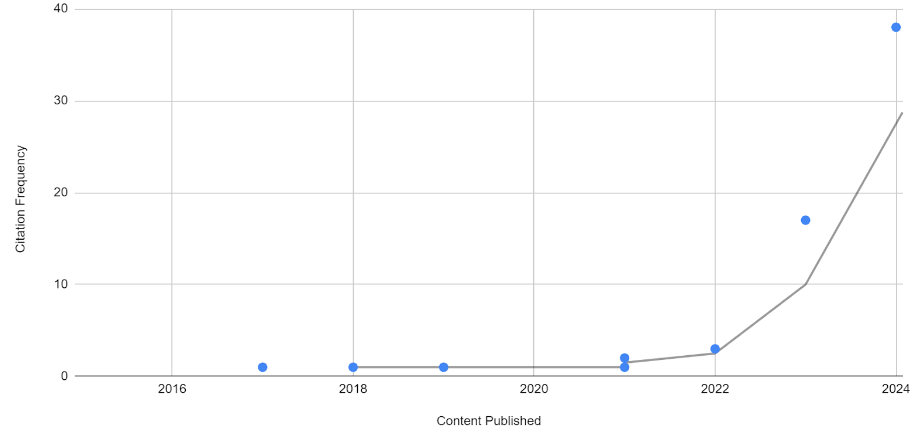How AI Overviews Are Affecting Black Friday & Cyber Monday Searches
AI Overviews bring both opportunities and challenges for eCommerce businesses.
As search trends shift, the growing role of AI-generated content in shaping user experiences around gift-related queries has sparked intriguing insights.
Our analysis of AI Overviews for gift-centric search terms reveals surprising patterns in source selection, ranking distribution, and content freshness.
Additionally, while most content cited is recent, with nearly 60% from 2024, some AI Overviews included dated sources from as far back as 2017.
This mix raises questions about AI’s prioritization strategies and potential biases in curating “hidden gems” over purely rank-driven selections.
Analysis Overview
- From a sample of Search terms targeting gift-related queries, AI Overviews were generated for 20% of them.
- Each AI Overview cited nine different sources (on average).
- Only 11% of sources cited by AI Overviews ranked in the top 100 classic search terms.
- AI Overviews for gift-related keywords, on average, consisted of 3 paragraphs and took up 684px of a search result page’s length (7.1 inches).
- It is possible for a domain to be cited twice in an AI Overview for a query, without “classically” ranking in the top 100 for that query.
Average Classic Rank of Organic Content Cited
The content ranking in AI Overviews often doesn’t match what appears in traditional search results.
This discrepancy suggests that Google might be using the AI Overviews as a testing ground, experimenting with how different sources perform for given queries compared to conventional organic rankings.
Only 7% of the sources cited in AI Overviews ranked in the top 10 classic results. In fact, only 11% of the sources cited ranked in the top 100.
The difference between Google ranking and ranking in AI overviews primarily revolves around the algorithms used, the criteria for evaluation, and the intended outcomes.
AI “rankings” are often based on machine learning models that analyze data and predict outcomes based on patterns rather than strict algorithms. These models can use natural language processing (NLP) to understand context and sentiment.
As our data shows, ranking prominently in “classic” organic search doesn’t guarantee prominence within AI Overviews.
“Christmas Gifts for Her”
For this query, the AI Overview cited 12 sources.

The first position in the source list ranked 5th in classic rank, and the second in the source list ranked 10th classically. The remaining 10 sources cited didn’t rank in the classic top 100 results.
Another good example of this behaviour is for a relatively high search volume search term, “Gifts for Her”.

The query “gifts for her” cited 12 different sources, of which only one (the first in the source carousel) ranked in the top 100 classic results, in position 39.
What’s more interesting is if we look at how much traffic the cited URLs receive (across all search queries for which they surface).
| AI Overview “Rank” | Classical Rank for specific query | Est. Monthly Organic Traffic (all queries) | Total AI Overviews for URL |
| 1 | 39 | 54,112 | 89 |
| 2 | 100 | 4,378 | 48 |
| 3 | 100 | 1,774 | 20 |
| 4 | 100 | 456 | 18 |
| 5 | 100 | 67 | 1 |
| 6 | 100 | 277 | 22 |
| 7 | 100 | 11 | 1 |
| 8 | 100 | 117 | 8 |
| 9 | 100 | 52 | 14 |
| 10 | 100 | 78 | 1 |
| 11 | 100 | 73 | 3 |
| 12 | 100 | 81 | 23 |
This suggests a correlation between topical relevance for the query cluster and presence within generative results being a factor, versus ranking directly for the specific query.
Age Of Content Cited
The content cited by AI Overviews ranged from static pages to blog pages and resources.
The publication dates of blog content cited ranged from 2017 to 2024, with stronger weighting to content published in 2023 (26%) and 2024 (59%).

Three of the content pieces cited were from the past week (7 days, 5 days, and 4 days).
Given that gift-related searches are time-sensitive, especially in the run-up to BFCM and Christmas, the frequency of content from 2024 and the latter end of 2023 isn’t surprising.
One might assume that for time-sensitive searches, such as gift-related queries, users would want to see results relevant to that time frame as they are researching potential purchases, and the top gifts of 2001 wouldn’t be useful.
The inclusion of articles from 2017, 2018, and 2019 is a bit of an anomaly and doesn’t align with assumptions.
The oldest cited source has had an interesting organic lifecycle, never really stabilising in terms of organic traffic and rankings:

But since October 2024, it has been selected for AI Overviews despite the ranking history and traffic stability.
The inclusion of this source given its lifetime performance and age is an anomaly, but could be the “hidden gems” initiative in action.
Is Google still “getting it right”?
Given the discrepancies in the classic ranking vs. AI citation data, there could be an argument that Google is still testing and finding a balance between “ranked content” and content immediately surfaced in the generative results.
This does raise the question that if the URLs (and content) being chosen for the generative result are valuable, why aren’t they “valuable” enough to be ranked highly in classic search results?
Additionally, reports from around the web suggest that content from sites allegedly impacted by “HCU” updates is still being cited, even when those sites aren’t ranking at all.
This might indicate that Google is using AI Overview results to further test how well these sites serve specific queries based on the AI’s selections.
This could also explain why some older, inconsistently ranking content is currently being included.
AI Overviews in eCommerce
With the introduction of AI Overviews, brand retailers might experience a decline in organic search traffic for queries related to their branded products.
This impact will extend beyond product detail pages, redirecting traffic toward other online retailers that offer these branded items.
Google’s algorithms may prioritize data and information from competitor sites that sell your branded products when generating AI Overviews.
Since AI Overviews essentially function as product listing pages (PLPs), they provide comprehensive product descriptions and carousels. Consequently, these PLP-like results could be populated with content sourced from other websites rather than your own.
When a customer selects a specific branded product, they will encounter a Product Knowledge Panel (PKP) displaying information from your product detail page (PDP) alongside offerings from other online retailers and distributors.
These competitors have enhanced their feeds with structured data to effectively showcase the same brands to potential buyers.
Embracing AI Overviews and understanding multi-modal search early can provide a competitive advantage. Businesses that are slow to adapt may find it challenging to reach potential customers and drive sales.